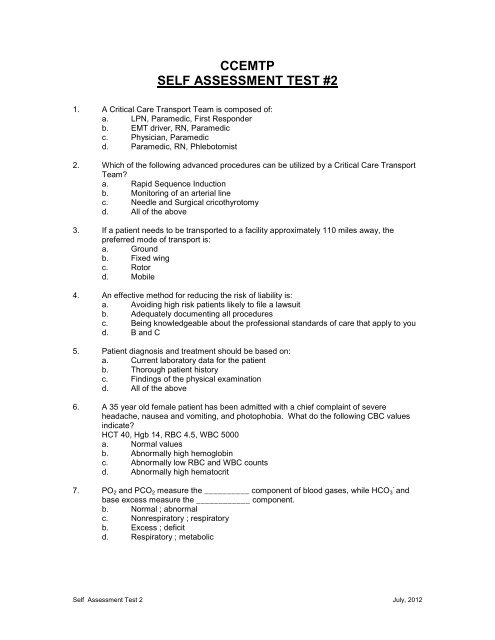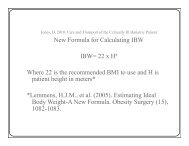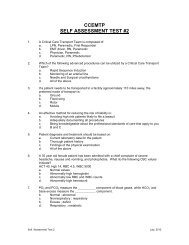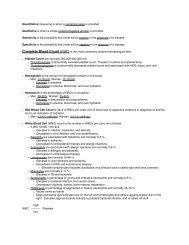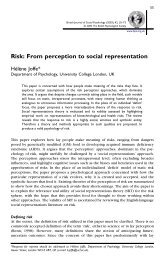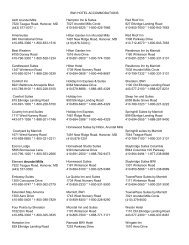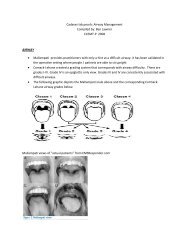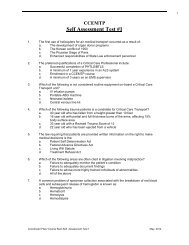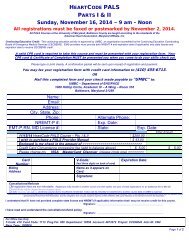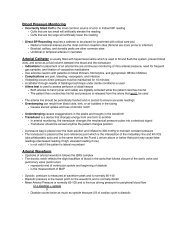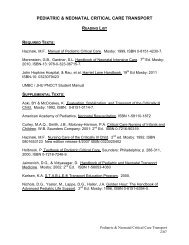SELF ASSESSMENT TEST #2
SELF ASSESSMENT TEST #2
SELF ASSESSMENT TEST #2
Create successful ePaper yourself
Turn your PDF publications into a flip-book with our unique Google optimized e-Paper software.
CCEMTP<strong>SELF</strong> <strong>ASSESSMENT</strong> <strong>TEST</strong> <strong>#2</strong>1. A Critical Care Transport Team is composed of:a. LPN, Paramedic, First Responderb. EMT driver, RN, Paramedicc. Physician, Paramedicd. Paramedic, RN, Phlebotomist2. Which of the following advanced procedures can be utilized by a Critical Care TransportTeam?a. Rapid Sequence Inductionb. Monitoring of an arterial linec. Needle and Surgical cricothyrotomyd. All of the above3. If a patient needs to be transported to a facility approximately 110 miles away, thepreferred mode of transport is:a. Groundb. Fixed wingc. Rotord. Mobile4. An effective method for reducing the risk of liability is:a. Avoiding high risk patients likely to file a lawsuitb. Adequately documenting all proceduresc. Being knowledgeable about the professional standards of care that apply to youd. B and C5. Patient diagnosis and treatment should be based on:a. Current laboratory data for the patientb. Thorough patient historyc. Findings of the physical examinationd. All of the above6. A 35 year old female patient has been admitted with a chief complaint of severeheadache, nausea and vomiting, and photophobia. What do the following CBC valuesindicate?HCT 40, Hgb 14, RBC 4.5, WBC 5000a. Normal valuesb. Abnormally high hemoglobinc. Abnormally low RBC and WBC countsd. Abnormally high hematocrit7.-PO 2 and PCO 2 measure the __________ component of blood gases, while HCO 3 andbase excess measure the ____________ component.b. Normal ; abnormalc. Nonrespiratory ; respiratoryb. Excess ; deficitd. Respiratory ; metabolicSelf Assessment Test 2 July, 2012
8. Which of the following blood gas values reflects compensation?a. pH 7.38; PCO2 60; HCO3 30b. pH 7.26; PCO2 55; HCO3 24c. pH 7.48; PCO2 30; HCO3 22d. pH 7.30; PCO2 32; HCO3 189. As a Critical Care Professional, you are legally obligated to a patient to:a. Distinguish what is right or wrong for the patientb. Have knowledge of policiesc. Provide a maximum level of competencyd. Provide reasonable and prudent care10. Increased Liver enzymes can indicate:a. TBb. Fluc. HIVd. Hepatitis11. A 26 year old has undergone extensive surgery requiring blood transfusions. Urinalysisreveals the presence of hemoglobinuria, a condition in which:a. There is an abnormal presence of blood in the urineb. Excessive hemoglobin is present for oxygen transportc. Hemoglobin is present in the urine, unattached to red blood cellsd. A and B12. A test used to determine the presence of occult blood in the GI tract is:a. Guaiacb. Prothrombinc. Thromboplastind. CSF13. Shock can occur as a result of fluid shifting from the intravascular space to theextravascular space. This can result from:a. Loss of extravascular integrityb. Decreased capillary membrane permeabilityc. Decreased colloidal osmotic pressured. None of the above14. The initial signs and symptoms of ___________ shock will be hindered if the patient istaking beta-blockers:a. Superficialb. Compensatedc. Decompensatedd. Irreversible15. Which of the following is least likely to develop Multiple System Organ Failure?a. An 86 year old female in septic shockb. A 12 year old with a spiral fracture of the left radius/ulnac. A farmer suffering from organophosphate poisoningd. A 26 year old male that is HIV positive16. Which of the following physiologic data is useful in diagnosing sepsis?a. Cultures of blood, urine, sputum or woundsb. Arterial blood gases reflecting hypoxia and respiratory alkalosisc. CBC reflecting elevated WBC countsd. All of the aboveSelf Assessment Test 2 July, 2012
17. Which of the following IS NOT a major component of the immune system?a. Leukocytesb. Lymphocytesc. Antigensd. Antibodies18. Transmission of the Herpes Zoster virus results in a disease known as:a. Hepatitis Bb. HIVc. Karposi Sarcomad. Shingles19. Which of the following statements is FALSE regarding right to left cardiac shunting?a. There is enough hemoglobin to carry the oxygenb. The heart is strong enough to circulate the bloodc. Some venous blood never passes through the lungsd. The lungs fail to fully oxygenate the blood20. In assessing a patient with asthma, the PaO2 will assist in obtaining information of whatnature:a. The effectiveness of ventilationb. The degree of dyspneac. The efficiency of gas exchanged. The patient's functional respiratory status21. Which of the following IS NOT a component of an arterial blood gas measurement?a. Acid-base balanceb. Bicarbonate levelsc. Oxygen saturationd. Hemoglobin22. Which of the following is/are CORRECT regarding a tension pneumothorax?I. It occurs when air leaks into the pleural space during inspiration and is trappedII. There should be adequate breath sounds on the affected sideIII. Absence of tracheal deviation would rule out pleural decompressionIV. Occurs as a result of penetrating, not blunt traumaa. I, IIb. II, IVc. III, IVd. I23. In regard to pleural decompression, the "Angle of Louis" is:a. The proper site for needle puncturesb. Used to locate the mid-clavicular linec. Used to locate the second intercostal spaced. Used to locate the lateral puncture siteSelf Assessment Test 2 July, 2012
24. 200 cc's of clear, amber fluid have been withdrawn from the right pleural space of apatient who has just undergone pleural decompression. Which of the following positionswould maximize the patient’s oxygenation?a. Fowler'sb. Left lateral recumbentc. Proned. Supine25. Which of the following is FALSE with regard to the indications for the placement of achest tube?a. Pleural effusionb. Hemothoraxc. Pulmonary embolusd. Pneumothorax26. Which of the following is the best way to determine proper chest tube positioning?a. Lung sounds are auscultatedb. A chest x-ray is performedc. ABG’s are drawnd. Oxygen saturation will increase27. Which of the following is CORRECT with regard to the ideal position for transporting apatient with a chest tube?a. Fowler’sb. Trendelenburgc. Supined. Left laterally recumbent28. Which of the following is CORRECT regarding the use of automatic ventilators?a. They are incapable of delivering higher minute volumes than the bag-valve maskb. Most units deliver controlled ventilation onlyc. Some units can be safely used in all age groupsd. The pop-off valves should be disengaged29. A patient on a portable ventilator suddenly develops dyspnea and unilateral chest pain.Lung sounds are absent on one side. Hypotension and tracheal deviation are alsopresent. Which of the following is the CORRECT action for these findings?a. Suction the patientb. Reposition the endotracheal tubec. Increase the V T on the ventilator until bilateral lung sounds returnd. Suspect a tension pneumothorax30. Which of the following is the most serious drawback of using positive pressure/demandvalves?a. Lung compliance cannot be feltb. High airway pressures are createdc. They consume a high volume of oxygend. They require an external power source31. Which of the following statements is CORRECT regarding ET suctioning?a. The maximum length of time for suctioning is 30 secondsb. Suction should be intermittently applied during catheter insertionc. Rigid suction catheters should not be used in trauma patientsd. Sterile technique is indicated when using a whistle-tip catheterSelf Assessment Test 2 July, 2012
32. Which of the following IS NOT a goal of Rapid Sequence Induction?a. Allows visualization of airway anatomy for the intubation of c-spine injurerpatientsb. Rapid airway control with minimal traumac. Prevention of aspiration and regurgitationd. Prevent rise in intracranial pressure33. Which of the following is FALSE regarding the use of succinylcholine?I. Its effects can be reversed with narcanII. It is administered at 1.5 mgIII. It is contraindicated in patients with agonal respirationsIV. It is a nondepolarizing muscle relaxanta. I, II, IIIb. II, III, IVc. IIId. I, II, III, IV34. Which of the following IS NOT an indication for a tracheostomy?a. To protect the lower airway from aspirationb. Reduce anatomical dead spacec. When intubation is delayedd. Long term mechanical ventilation35. Proper lung auscultation includes listening to breath sounds:a. For a full minute at the apex and baseb. For a full breath at the apex and base, anterior and posterior (6 places)c. Where the suspected problem liesd. Every 3-5 minutes in critical patients36. Which of the following is CORRECT regarding the most lethal early complication oftracheostomy?a. Tracheal stenosisb. Pneumoniac. Previous intubationd. Accidental displacement of the tube37. Which of the following is CORRECT with regard to needle cricothyrotomy?a. It requires more time as compared to a surgical cricothyrotomyb. It requires minimal equipmentc. A more definitive airway is urgently warrantedd. Retrograde airflow through the mouth and nose are not a concern38. Airflow into the lungs during inspiration depends on all of the following EXCEPT:a. Contraction of the muscles of respirationb. Enlargement of the thoracic cavityc. Lowered intrathoracic pressured. Relaxation of the diaphragmSelf Assessment Test 2 July, 2012
39. Which of the following procedures should be attempted prior to establishing a surgicalairway?I. Needle cricothyrotomyII. Heimlich maneuverIII. IntubationIV. Mechanical removal of an obstruction with forcepsa. I, II, IIIb. I, II, IVc. I, III, IVd. II, III, IV40. Which of the following is CORRECT regarding retrograde intubation?I. It requires hyperflexion of the neck.II. It can be performed despite the presence of blood in the upper airway.III. It is an alternative to cricothyrotomyIV. It may be used if orotracheal intubation is contraindicateda. I, III, IVb. I, II, IIIc. II, IVd. II, III, IV41. To perform retrograde intubation, the guide wire must be:a. Approximately 30 mm. in lengthb. Approximately 70 cm. in lengthc. Long enough to cover the distance between the nares and the sterno-clavicularangled. B and C42. Which of the following is FALSE regarding non-tunneled catheters?a. They are large bore cathetersb. They may have single or multiple lumensc. They may be inserted centrally or peripherallyd. They are used for short term therapy43. When a pulmonary artery catheter is wedged, what information is available?a. Right atrial blood flow dynamicsb. The cardiac outputc. Electrical activity in the heartd. The left ventricular end-diastolic pressure44. A Swan-Ganz catheter is in place. Which of the following would be an inappropriateaction if no waveform shows on the monitor?a. Flush the catheterb. Check the monitor calibrationc. Check the position of the stopcockd. Check for loose connections45. Which of the following is CORRECT regarding the nature of an abnormal SVR?a. 400 dynes/sec/cm 5b. 1000 dynes/sec/cm 5c. 1200 dynes/sec/cm 5d. 1400 dynes/sec/cm 546. Which of the following is CORRECT regarding the purpose of zero referencing?a. It calibrates the transducer to known accurate mercury manometerSelf Assessment Test 2 July, 2012
. It balances the transducer to atmospheric pressurec. It matches the dome of the transducer to the phlebostatic axisd. It levels the transducer for accurate readings47. Which of following is CORRECT regarding the formula?Systolic + 2 diastolic =3a. RVCb. MAPc. Pulse pressured. Pulmonary capillary wedge pressure48. Which of the following would result in low values on the monitor?I. Transducer above phlebostatic levelII. Transducer below phlebostatic levelIII. Air bubbles or clot in the catheterIV. Catheter flinga. I, IIb. II, IIIc. I, IIId. II, IV49. Which type of blood preparation would eliminate disease transmission and the possibilityof transfusion reaction?a. Autologousb. Homogolousc. Defibrinogenatedd. Elimination of these risks is not possible50. Which of the following is CORRECT regarding the major determinants of bloodcompatibility?a. ABO blood groups and the Rh systemb. Age and sex of donor and recipientc. Hemoglobin and hematocritd. Type of blood product51. Which of the following is CORRECT in regard to reducing the risk of volume overload,when multiple units of blood are to be infused?a. Whole bloodb. Immune globulinsc. Specific factor therapyd. Packed red blood cells52. Which of the following is CORRECT regarding the primary importance when preparing toadminister blood?a. Documenting baseline vital signsb. Administering normal salinec. Asking a second professional to confirm blood compatibilityd. Obtaining a written order for the transfusion53. Hemolytic transfusions can occur as long as ___________ after transfusion:a. 2 hoursb. 2 daysc. 14 daysd. 1 weekSelf Assessment Test 2 July, 2012
54. Which of the following statements is/are FALSE?I. The muscular layer of the heart is the endocardiumII. The two-layered sac surrounding the heart is the pericardiumIII. The lining of the heart chambers is the epicardiumIV. One of the three layers of tissue that form the wall of the heart is theendometriuma. Ib. I, IIIc. III, IVd. I, III, IV55. Which of the following is CORRECT in regard to the nervous system control of the heart?a. The sympathetic nervous system innervates the heart through the cardiac plexusb. The vagus nerve acts as a cardiac acceleratorc. Norepinephrine is the chemical neurotransmitter for the parasympathetic nervoussystemd. The release of acetylcholine speeds the heart rate56. Which of the following is FALSE in regard to the electrophysiology of the heart?a. The normal electrical state of cardiac cells is known as the action potentialb. When myocardial cells are stimulated, there is a rapid influx of sodium ionsc. When sodium ions rush into a cell, the cell becomes positively chargedd. There are three types of cardiac cells: pacemaker, electrical conducting, andmyocardial57. Which of the following is CORRECT regarding lead placement for the 12 Lead ECG?a. Leads I, II, III are unipolar chest leadsb. Leads AVR, AVL, AVF are unipolar limb leadsc. Leads V1-V6 are bipolar chest leadsd. B and C58. Which of the following is CORRECT in regard to the components of theelectrocardiogram?a. The ST segment reflects the time from the end of ventricular depolarization to thebeginning of ventricular depolarizationb. The shape and appearance of a waveform is referred to as the morphologyc. The normal PR interval is 0.10- 0.12 secondsd. The horizontal axis on ECG paper measures voltage, while the vertical axismeasures time59. A 59 year old male has been diagnosed with an inferior wall infarction. Which of thefollowing statements is CORRECT regarding his 12 Lead interpretation?a. Indicative changes in Leads II, III, and AVF suggest the infarct is due to rightcoronary artery occlusionb. Indicative changes in leads viewing the septal, anterior, or lateral walls of the leftventricle suggest the infarct is due to left coronary artery occlusionc. Lead AVR is not critical to this diagnosisd. All of the above60. Which of the following IS NOT a primary component of 12 Lead ECG interpretation?a. Assessing Q wave presence and morphologyb. Calculation of the electrical axis of the T wave and P wavec. Inspection of P waves for hypertrophyd. Assessment of ST segment for elevation or depressionSelf Assessment Test 2 July, 2012
61. Which of the following is CORRECT in regard to aberrant conduction?a. It represents a normal findingb. It results in a supraventricular beat conducted through the ventricles in adelayed mannerc. It is easy to distinguish PJCs with aberrancy from PVCs in Lead IId. It is an atrial conduction disturbance62. Which of the following is CORRECT regarding the criteria used to diagnose bifasicularblocks?a. Widened QRS, “rabbit ears” in leads V 1 and V 2b. A negative deflection in Lead AVFc. Right axis deviation in Lead Id. A and B63. Myocardial injury can be indicated on an ECG by:a. A depressed ST segmentb. An elevated ST segmentc. The absence of a P waved. The presence of U waves64. Which of the following statements is CORRECT with regard to patients with an ICD?a. Have a one year mortality rate from SCD of only 10%b. Include those with recurrent inducible heart blocks refractory to medical therapyc. Can lead a normal life in regard to activity level or traveld. Should avoid hand held metal detectors65. Which of the following represents information that should be obtained to helptroubleshoot a pacemaker problem:a. Pacemaker rate, output, and sensitivity parametersb. The patient’s present underlying rhythmc. The type and position of the leadsd. All of the above66. Which of the following is FALSE with regard to the indications for Intra-Aortic BalloonPump (IABP) counter-pulsation?a. Aortic valve incompetenceb. Cardiogenic shock secondary to infarctionc. Postoperative left ventricular failured. Severe unstable angina67. The IABP catheter is attached to a machine which:a. Removes gas from the aortab. Displays the patient’s ECG and arterial waveformc. Has an electronic trigger mechanism for the balloon pumpd. B and CSelf Assessment Test 2 July, 2012
68. Place the following steps in appropriate order to assess proper balloon pump timing:I. Identify the dicrotic notch, and determine that inflation occurs at this pointII. Deflate the balloon just before systoleIII. Compare the slopes of systolic upstroke and diastolic augmentationIV. Identify the beginning of systole and diastole on the arterial waveformV. Evaluate the systolic pressure peak to determine that it is lower than theunassisted systolic pressure peaka. I, IV, V, II, IIIb. III, IV, I, V, IIc. IV, I, III, II, Vd. V, III, IV, I, II69. Which of the following is/are CORRECT with regard to a contraindication for the use ofan IABP?a. Aortic aneurysmb. Ventricular septal defect following infarctionc. Severe peripheral vascular occlusive diseased. A and C70. Which of the following statements is/are CORRECT with regard to the proper positioningof the intra-aortic balloon?a. Is often achieved by using the Cramer technique for catheter placementb. Requires balloon placement beneath the renal arteriesc. Requires balloon placement in the thoracic aorta, distal to the left subclavianarteryd. B and C71. Which of the following is a complication associated with IABPs?a. Arterial insufficiencyb. Infectionc. Gas embolismd. All of the above72. Which of the following is CORRECT in regard to the proper timing of the balloon pump?a. A patient with a heart rate of 80 bpm requires balloon inflation during diastole for1450-1500 msecb. An arterial catheter must be in place to monitor timingc. The dicrotic notch identifies the point of balloon deflation during systoled. The final step in timing is the identification of the beginning of systole anddiastole on the arterial waveform73. Haloperidol is indicated for:a. Substernal chest painb. Acute psychotic episodesc. Comad. Depression74. The mechanism of action for Benzodiazepines includes :a. Stimulating beta 1 and beta 2 adrenergic receptorsb. Inhibiting pre and post synaptic dopaminec. Inhibiting postaglandin synthesisd. All of the aboveSelf Assessment Test 2 July, 2012
75. Which of the following statements is CORRECT in regard to how Flumazenil works?a. Antagonizing Barbiturate and Opiate receptor sitesb. Antagonizing Benzodiazepine receptor sitesc. Increasing systemic vascular resistanced. Exerting a positive inotropic effect on the heart76. Which of the following is/are true about Morphine?I. It is a central nervous system stimulantII. It binds with opiate receptors in the brainIII. Nausea and vomiting frequently accompany administrationIV. Its duration is 3-7 hoursa. I, IIb. II, IIIc. I, II, IIId. II, III, IV77. A nondepolarizing neuromuscular blocking agent used to maintain paralysis followingintubation, and lasting approximately 30 minutes:a. Vecuroniumb. Diazepamc. Succinylcholined. Pancuronium78. Which of the following is/are CORRECT in regard to the classification of Albumin andDextran:a. Crystalloidsb. Colloidsc. Plasmanatesd. All of the above79. Which of the following is/are true regarding the use of Dextran:I. It is a glucose polymer in normal saline or D 5 WII. It has more colloid properties than AlbuminIII. It expands 3 ml per every 1 ml administeredIV. It is administered at a rate of 2 gm/kg in the first 24 hoursa. Ib. IIc. I, IIId. I, IV80. Which of the following IS NOT a vasopressor?a. Norepinephrineb. Epinephrinec. Dopamined. DobutamineSelf Assessment Test 2 July, 2012
81. Which of the following is FALSE regarding the use of Dobutamine?a. It improves the force of cardiac contractionb. It increases cardiac output and urine outputc. It can result in hypotension and tachycardia at 15-20 mcg/kg/mind. It has significant chronotropic effects82. Which of the following is FALSE regarding the use of Albuterol?a. It is a very potent bronchodilatorb. It can last for 4-8 hoursc. It is administered via nebulizer at a dose of 0.25 mgd. It is commonly available in aerosol form83. Which of following is CORRECT in regard to Anticholinergics?a. Are more potent than beta agonistsb. Have a more rapid onsetc. Have a longer durationd. Produce bronchodilation in cholinergic mediated bronchoconstriction84. An example of a Class III Antiarrhythmics would be:a. Amiodaroneb. Propranololc. Adenosined. Verapamil85. Which of the following is/are CORRECT in regard to the use of Amiodarone?a. It has a short half-lifeb. It can be used in lower doses to improve renal functionc. It is administered in an initial dose of 300mg for cardiac arrest due to shockresistant V-Fibd. All of the above86. Which of the following is/are CORRECT regarding the use of beta blockers?I. The higher the dose, the more they lose selectivityII. Their adverse effects include fatigue and malaiseIII. They are indicated for hypertensionIV. caution should be exercised when giving to CHF patientsa. I, IIb. II, IVc. I, III, IVd. I, II, III, IV87. Similarities between Streptokinase and TPA include:a. Both convert plasminogin to plasminb. Both cost approximately the samec. Both have the same half lifed. A and C88. You need to administer a loading dose of 5 mg/kg of Aminophylline to a 110 pound adultfemale with asthma. This dose is to be administered over 30 minutes. You have a 250 mlbag of normal saline, a 500 mg vial of Aminophylline, and a 10 gtts/cc administration set.What will be the concentration of the Aminophylline when mixed in the bag?a. 1 mg/ mlb. 2 mg/ mlc. 3 mg/ mld. 4 mg/ mlSelf Assessment Test 2 July, 2012
89. What is the actual dose of Aminophylline to be administered to the patient?a. 100 mgb. 250 mgc. 400 mgd. 500 mg90. How many milliliters of Aminophylline must you administer?a. 50 mlb. 100 mlc. 125 mld. 250 ml91. How many gtts/min would you run this initial drip?a. 33 gtts / minb. 42 gtts / minc. 66 gtts / mind. 83 gtts / min92. You must administer a Dopamine infusion at 10 mcg/kg/min to a 176 pound male withhypotension associated with cardiogenic shock. You have 200 mg of Dopamine, a 250 mlbag of D 5 W, and a 60 gtts/cc administration set. How many drops per minute should youinfuse?a. 15b. 30c. 45d. 6093. A patient presenting with profuse hematemesis with frank red blood, and a historyof significant alcohol abuse is/are mostly likely caused by:a. Kidney stonesb. Esophageal varicec. Gastric hemorrhaged. B and C94. Which of the following IS NOT an abnormal finding in the abdominal assessment:a. Rebound tendernessb. Shoulder discomfortc. Bowel sounds heard approximately every 15-30 secondsd. Consistent rigidity and guarding of the abdominal wall95. A thin female patient is supine on the cot during your assessment. You palpate a strongpulse at her umbilicus. This is likely due to:a. The normal condition of her abdominal aortab. An abdominal aortic aneurysmc. An ectopic pregnancyd. A gross anatomic abnormality96. You have just received a patient with a nasogastric tube already in place. When youinject air into the tube and auscultate the epigastrium, nothing is heard. Your next actionis to:a. Remove the tube and reattempt placementb. Transport the patient; the tube is adequatec. Place the patient in the lateral recumbent position for better auscultationd. Place an additional orogastric tube in the patient prior to transportSelf Assessment Test 2 July, 2012
97. Which of the following actions can help prevent diarrhea and other gastrointestinalcomplications associated with enteral feedings?a. Increasing the rate of feedingsb. Decreasing the amount of water being added to the nutritional solutionc. Administering the feeding as a bolus every 2 hoursd. Changing the administration set every 24 hours98. Which of the following statements is/are CORRECT with regard to the purpose of a Foleycatheter?a. Observe the condition of urine for blood and other abnormal contentsb. Allow urine to freely exit the bodyc. Closely monitor urine volume productiond. All of the above99. No urine is found in the Foley catheter after placement. This could be caused by:a. Incorrect placement of the catheterb. An empty urinary bladderc. The catheter clamp remains in placed. All of the above100. Following placement of a Foley catheter, the patient develops an infection. Which of thefollowing is not a sign or symptom of that infection?a. WBCs in the urine cultureb. Clear urinec. Feverd. Altered mental status101. A colostomy is a surgical procedure likely required for patients with:a. Obstruction of the small intestineb. Rectal cancerc. Blood accumulation in the stomachd. All of the above102. Which of the following will be altered by renal failure?a. pH levelb. Blood pressurec. Hematocritd. All of the above103. Which of the following IS NOT a risk factor for a patient undergoing peritoneal dialysis?a. Fistula graft rejectionb. Peritonitisc. Decreased bowel soundsd. Elevated white blood cell count104. Which of the following is/are a cause of hypotension during or following dialysis?a. Disequilibrium syndromeb. Anxiety about the procedurec. Excessive filtration of the bloodd. Infectious processes associated with the procedureSelf Assessment Test 2 July, 2012
105. An inappropriate motor response in a comatose patient characterized by flexion of thearms, wrists, and fingers, adduction of the upper extremities, and extension, medialrotation and planter flexion of the lower extremities is known as:a. Decerebrate postureb. Dysphasia posturec. Decorticate postured. Fasciculation posture106. When documenting deep muscle reflex response, a grade of ____ is used to indicate anormal or expected response.a. 2b. 3c. 4d. 5107. The intracranial volume-pressure curve demonstrates the relationship between:a. Changes in blood pressure and intracranial pressureb. Changes in brain mass and intracranial pressurec. Changes in volume and intercranial pressured. Changes in volume and intracranial pressure108. Which of the following is FALSE regarding the advantages of using an interventricularcatheter (IVC)?a. Ability to drain CSF to lower ICPb. Reduced risk of infectionc. Increased accuracy in ICP monitoringd. Reliability109. A 42 year old patient with serious head trauma has an intracranial pressure of 19 mmHg.This indicates that his ICP is:a. Normalb. Slightly elevatedc. Moderately elevatedd. Severely elevated110. Mean arterial pressure (MAP), minus intracranial pressure (ICP), equals ______:a. Coronary artery pressure (CAP)b. Central venous perfusion pressure (CVPP)c. Cerebral perfusion pressure (CPP)d. Cervical spinal fluid pressure (CSFP)111. Which of the following drugs will cause an increase in ICP?I. KetamineII. DiazepamIII. NitroprussideIV. MannitolV. Oxygena. I, III, IV, Vb. I, II, IIIc. II, III, IVd. I, III, VSelf Assessment Test 2 July, 2012
112. In order to decrease ICP, the patient's head should be:a. Aligned with neckb. Hyperextendedc. Hyperflexedd. Rotated to the left113. Which of the following is CORRECT with regard to the amount of circulating bloodvolume of a neonate?a. 30-40 cc/kgb. 70-75 cc/kgc. 50-60 cc/kgd. 85-90 cc/kg114. When comparing the adult and pediatric respiratory systems, which of the following isCORRECT with regard to the pediatric patient?a. Children are mouth breathersb. The diaphragm is the chief muscle of respirationc. Intercostals & accessory muscles are strongd. Pediatrics have smaller tongues115. When administering medications via the ETT to neonates and pediatrics, which of thefollowing IS NOT given at 2-3 times the usual dose?a. Lidocaineb. Atropinec. Epinephrined. Narcan116. You are preparing to perform RSI on a 6 year old child with multiple system trauma. Ofthe following medications used for RSI which has the CORRECT dosage listed:a. Flumazenil 0.05-0.1 mg/kg IV/IO/IMb. Etomidate 2-6 mg/kg IV/IOc. Vecuronium 0.01-0.5 mg/kg IV/IOd. Succinylcholine 1-4 mg/kg IV/IO117. In a pediatric patient with a fever, the heart rate increases _________ BPM for every 1 ْ◌ºC above 37° C:a. 5b. 20c. 10d. 15118. An early sign of shock in a pediatric patient is:a. Prolonged capillaryb. Bradycardiac. Decreased pulse pressured. Hypotension119. The antihypertensive medication of choice for managing severe Pre-eclampsia is:a. Magnesium Sulfateb. Labetalolc. Hydralazined. NifedipineSelf Assessment Test 2 July, 2012
120. In regard to third trimester bleeding which of the following is/are CORRECT?a. Dopamine given in low doses will preserve placental blood flowb. The dose for dobutamine is 5-15 mgm/kg/minc. Hemodynamic compromise is commond. All of the above121. Which of the following is CORRECT with regard to pre-term labor?a. Magnesium sulfate is not recommendedb. Is defined as uterine contractions without cervical changec. Tertbutaline is administered at 0.25 mg SQ every 15 mins times 3 dosesd. Is defined as greater than 37 weeks gestation122. Treatment of a prolapsed umbilical cord includes the following:a. Reinserting the cord in the vaginab. Changing maternal position to knee-chestc. Clamping and cutting the cordd. Pulling on the cord to speed up delivery123. Which of the following differentiates Pre-Eclampsia from Eclampsia?a. Grand Mal Seizuresb. Hypertensionc. Anxietyd. Photophobia124. Which of the following can cause fetal tachycardia?I. Parasympatholytic drugsII. Sympathomimetic drugsIII. ChorioamnionitisIV. Maternal feverV. Fetal hypoxiaa. I, II, Vb. II and IVc. I and IId. All of the above125. A 25 year old male has been burned on the anterior portion of his left arm from the elbowto the wrist, on one half of his chest and on the left side of his face. Based on the “Rule ofNines” what is the percentage of total body surface area burned?a. 30%b. 18%c. 25%d. 20%126. When transporting a patient with a circumferential burn of the extremity, theCritical Care Professional must be concerned with which of the following:a. The need for an escharotomyb. Compartment syndromec. The need for a fasciotomyd. All of the aboveSelf Assessment Test 2 July, 2012
127. Which of the following chemicals would produce the most serious burns?a. An alkali solutionb. Acetic acidc. Dry lyed. Diesel fuel128. Another method for measuring the percent of total body surface area burned isthe:a. Rule of the Palmb. Parkland Formulac. Injury Severity Scaled. Ashford Formula129. Severity of a burn is determined by which of the following:I. DepthII. AgeIII. The color of the flameIV. HistoryV. Method used to extinguish the flamea. I, II, III and Vb. I, II and IIIc. I, II and IVd. All of the above130. Which of the following patients meets the criteria for transport to a burn center?a. A partial thickness burn of 10%b. Superficial burns of > 50%c. Partial and full thickness burns of > 20% BSAd. All of the aboveSelf Assessment Test 2 July, 2012


